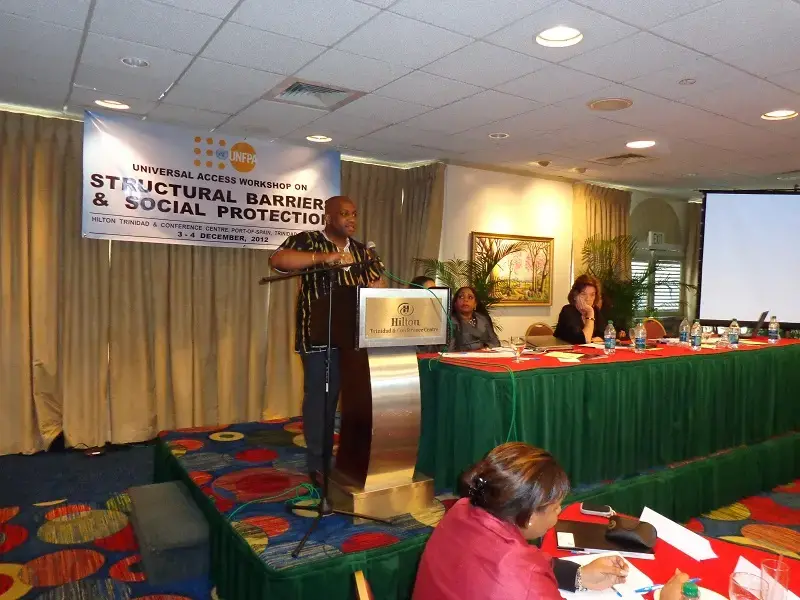For Senior Officers in the ministries of National Security, Justice, Education and Health
STRUCTURAL BARRIERS and SOCIAL PROTECTION
Structural barriers and environmental factors include social norms, poverty, gender inequalities, policies, laws, regulations, systems and procedures that influence an individual’s ability to reduce HIV transmission and acquisition. Criminal laws inherited from colonial legislation result in the absence of legal protection for certain groups of population, particularly MSM, sex workers and drug users and consequently invasion of their privacy, inequity by relegating them to inferior status, degradation of their dignity by declaring them unnatural, violence and blackmail, and abuse and destruction of their careers and lives. Dissonance between the age of consent and age for access to services and prevailing cultural and moral stances continue to impede the provision of services to young people.
Stigma and discrimination is the most potent result of structural barriers but the two are also self-reinforcing drivers of the HIV epidemic. UNAIDS has identified three epidemics in the fight against HIV: The epidemic of HIV Infection, the epidemic of AIDS and the epidemic of stigma and discrimination. It is noted that the latter is equally or more dangerous than the infection and disease, because it creates and perpetuate a hostile environment of stigma and discrimination against key vulnerable populations including sexually active young people, people who sell sex and men who have sex with men.
Where stigma and discrimination are high or common place in communities, these key vulnerable populations are subject to social exclusion, ostracism, marginalization, violence, extortion and poverty among other negative outcomes. Stigma and discrimination militates against the right to health because key vulnerable populations avoid contact with social services including health service due to shame or for fear of discrimination, judgement, ridicule, sanctions and arrest in some instances. This reality has severe implications for the general public health of communities, incomes of individuals and families, living standards and quality of life.
Social protection is therefore critical in environments of high stigma and discrimination. It is all public and private initiatives that protect the vulnerable against livelihood risks and enhance social status and rights of the marginalized with the overall objective of reducing economic and social vulnerability of the poor, vulnerable and marginalized groups.
UNIVERSAL ACCESS
The primary mandate of the United Nations is the promotion advocacy and enforcement of the Human Rights of all people, including the right to health, freedom from discrimination, privacy and to benefit from scientific progress. UNFPA focuses on right to health, specifically the right to Universal Access to Sexual and Reproductive Health (SRH) Information, Education, Services and Commodities. The experience of global HIV response has demonstrated the following lessons:
- Promoting public health and protecting human rights are mutually reinforcing. The health of the general population is directly related to the health of key vulnerable populations.
- HIV is a security and a developmental issue as it destroys the very fabric of what constitutes a state: individuals, families, communities, economic and socio-political institutions, and the military and police forces which guarantee the protection of state institutions.
- An effective response to HIV will rely on a multitude of robust programme initiatives, many of which will be led by sectors outside of health.
- Reducing the transmission of HIV is directly dependent on universal access to sexual and reproductive health information, education, services and commodities.
- Universal access is most successful in settings where stigma and discrimination is controlled, reduced and/or eliminated.
- Addressing stigma and discrimination requires robust engagement and ownership by a multitude of sectors including health, education, youth, security and justice among others.
THE WORKSHOP
In light of the foregoing, UNFPA in conjunction with UNICEF, UNAIDS, PANCAP and UNDP hosted a regional workshop to build the capacity in the region to critically evaluate and address the structural barriers to Universal Access to Sexual and Reproductive Health and opportunities for Social Protection, particularly for key vulnerable populations. The workshop focused on the perspectives and realities of the ministries of Justice and National Security in recognition of and response to their untapped capacity to impact national HIV responses. Specifically, this workshop:
- Examined the structural barriers to Universal Access to SRH from the perspective of ministries of security, justice, health and education
- Profiled experiences, strategies and best practices of the ministries in addressing structural barriers to Universal access to SRH and Social Protection
- Evaluated and capitalize on inter-ministerial and inter-country synergies in addressing structural barriers to SRH and meeting social protection needs
- Articulated a technical assistance plan for capitalizing on identified opportunities over the medium and long term
Universal Access Workshop Documents
For Additional Information Contact
| Mr. Marvin Gunter |
| HIV and AIDS Advisor |
| United Nations Population Fund |
| gunter@unfpa.org |
Marvin Gunter


